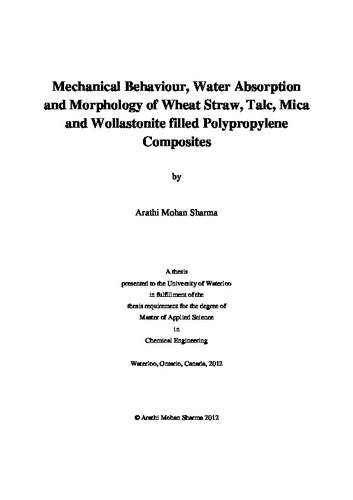| dc.description.abstract | Polypropylene continues to be the mainstream choice thermoplastic for automotive applications. In many applications PP is filled with mineral fillers for improvement of properties. Biobased natural fillers or fibres are attractive materials to reduce the weight because of the low specific gravity of the biobased materials compared to the mineral fillers.
Our group has done extensive research on the development of wheat straw fiber in thermoplastics in the past years. It is very important to understand the behaviour of single fillers on composites before studying the effects of mixing fillers or fibers (hybridization). The objective of this study is to evaluate and compare systematically the effects of wheat straw and mineral fillers in the polypropylene matrix. The study includes two types of wheat straw (WS) categorized based on their size (fine WS and medium WS) and three different types of natural minerals (Talc, Mica and Wollastonite). Three types of polypropylene (PP), Homopolymer PP, High Impact Copolymer PP and Homopolymer-Copolymer Blend PP, were investigated as the matrix. This study also evaluates the effect of combining two fillers (WS and mineral filler) in the hybrid composite. The fillers were formulated in three different percentages (20, 30 and 40wt %) and compounded via extrusion. Samples for all formulations were prepared by injection molding. The mechanical properties (flexural modulus and strength, tensile modulus and strength, impact strength), water absorption and density were measured. The properties of hybrid composites were evaluated by varying the amounts of two fillers at 10wt%-20wt%, 15wt%-15wt% and 20wt%-10wt% each, keeping the overall filler content constant at 30wt%.
The effect of type of filler, filler size and filler content were critical in this work. The results obtained from this study indicated that filler type and filler content greatly influenced the mechanical properties and water absorption characteristics of the composites. The flexural modulus increased with increasing filler content. It was interesting to observe that though the impact strength decreased with the addition of fillers, increasing the filler content from 20 to 40 wt% did not affect the property. With respect to all fillers, wollastonite improved the mechanical properties significantly. Increasing the amount of WS content reduced the composite’s resistance to water absorption. Among mineral fillers, mica showed significantly higher percentage gain in weight with water absorption. Combination of fillers at varying percentages did not have any synergy effect on the mechanical behaviour of the composite. The percentage increase in weight with water absorption was observed to be increasing with increasing WS content in hybrid composites, but significantly lower than pure WS composites. The morphological study on WS composites revealed improved interaction of filler with homopolymer and polypropylene blend. | en |

